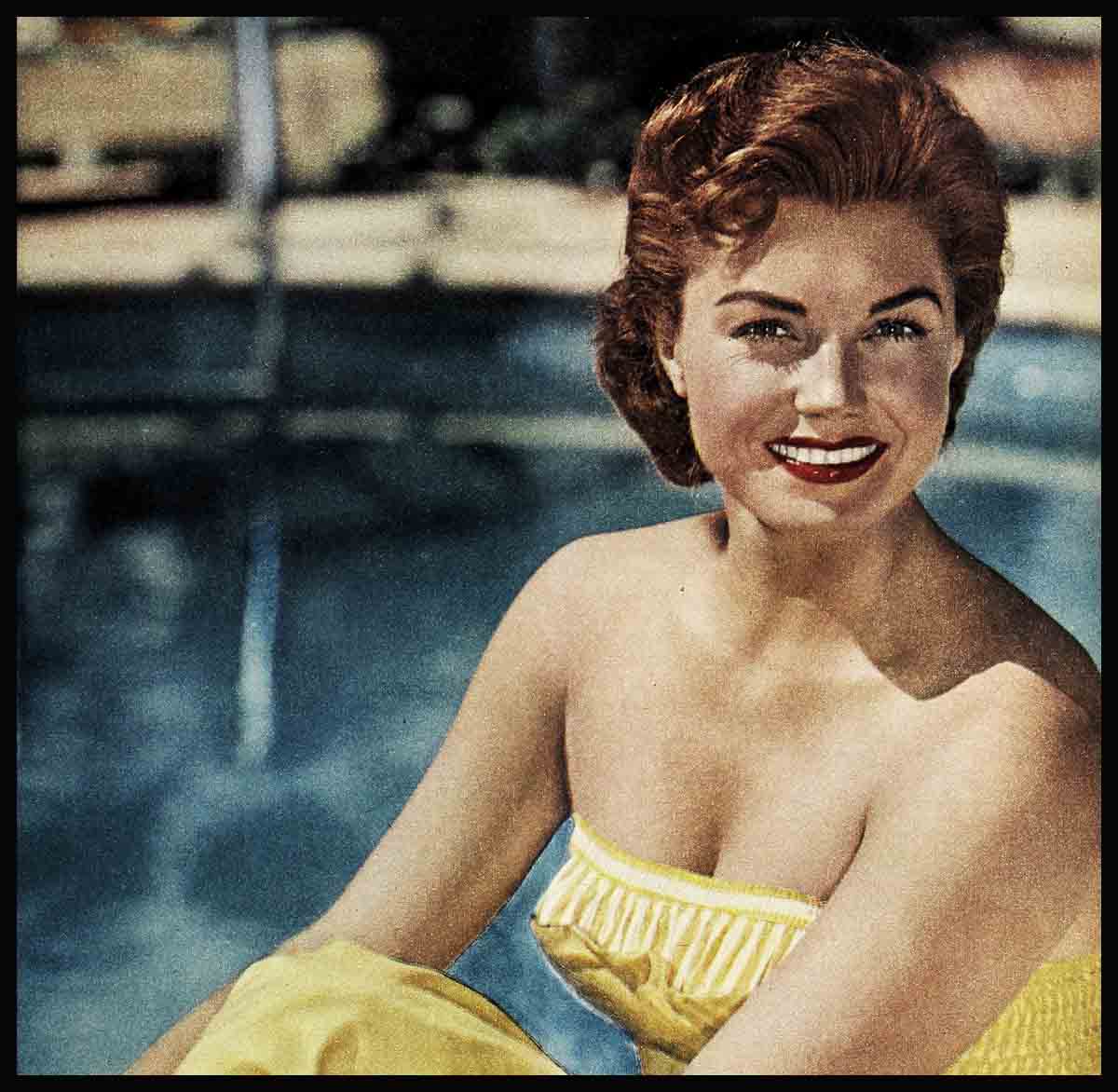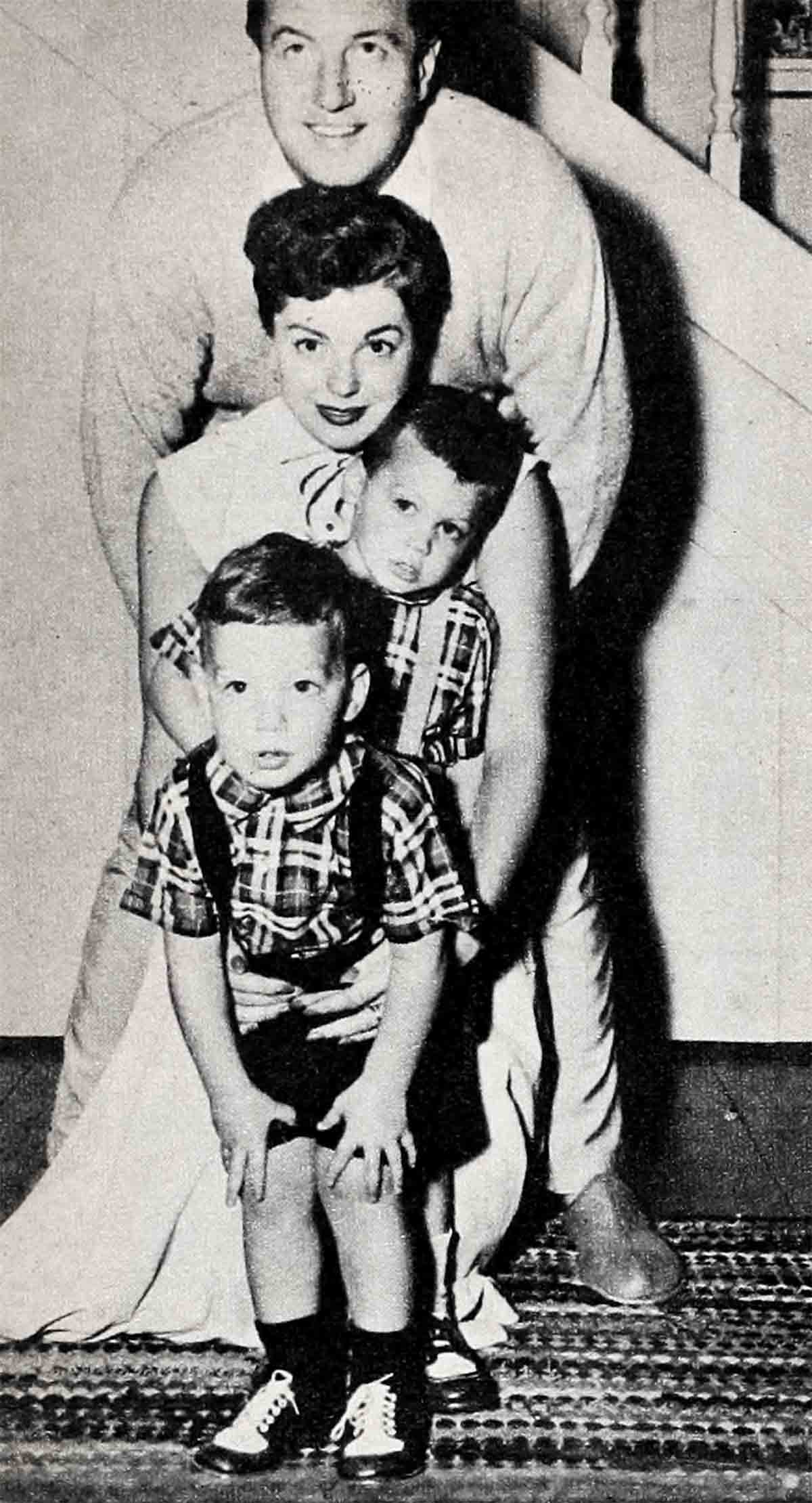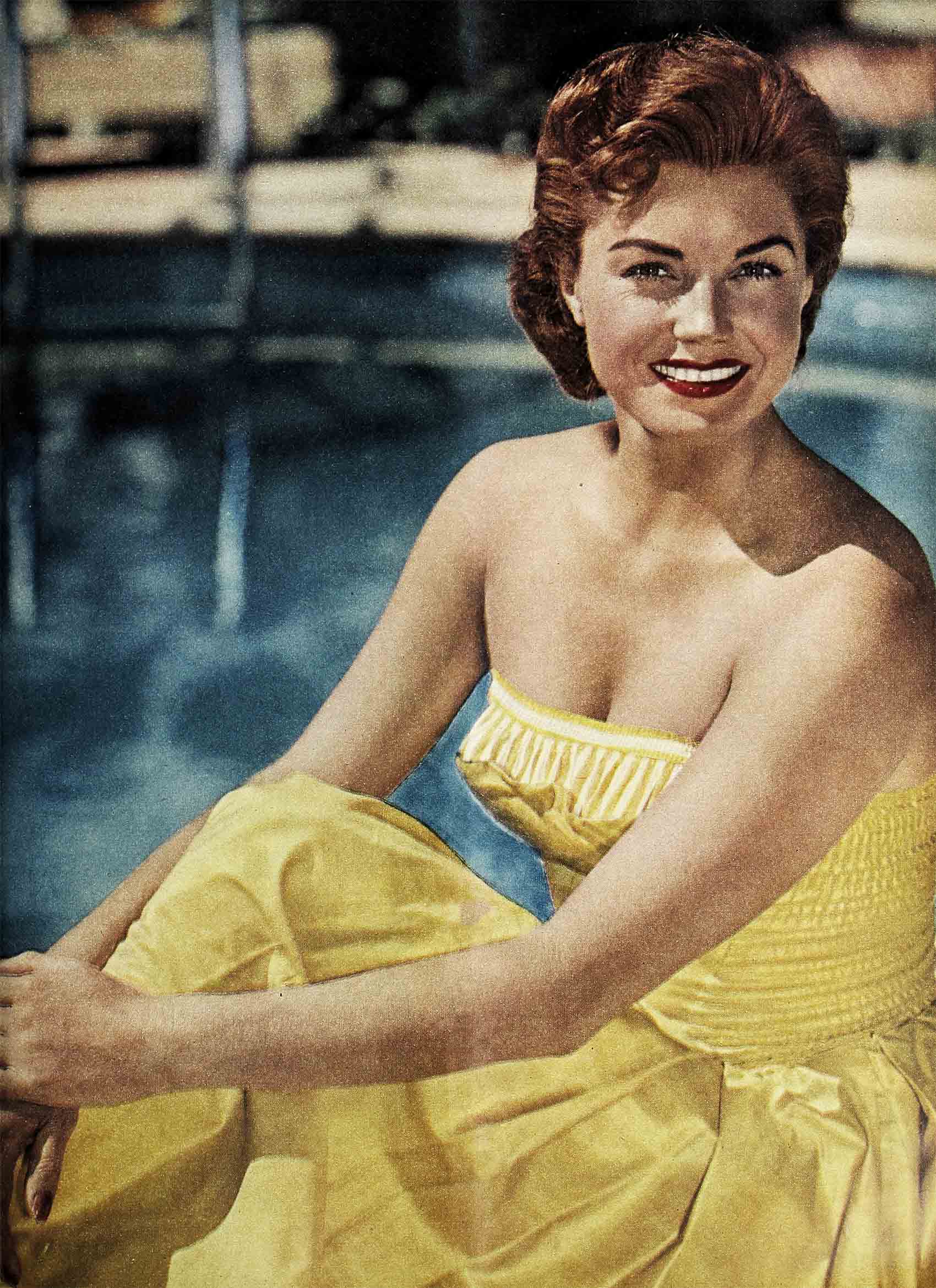
Everywhere That Esther Williams Goes . . .
Having finished his lunch, Kimball Austin Gage went for a stroll down the airplane aisle. He paused beside a friendly-faced gentleman and decided to say a few words. “I’m an Indian,” he said amiably.
“Thatso?” replied the fellow passenger.
“Benjie’s the cowboy. He’s chasing me,” volunteered Kimmie, standing pretty still for an Indian on the run.
The man eyed the aisle. No lasso shot out. No six-shooters blazed. The cowboy named Benjie was nowhere in sight. “He won’t catch me,” Kimmie offered hasty assurance. “Not till we get to Florida, anyway.”
Obviously the paleface was thinking in terms of ambush. “Just how can you be certain?”
“He’s on the other plane,” explained Kimmie.
The gentleman shook his head. “The game’s surely changed since I played it.”
Esther Williams smiled as she listened to her son’s conversation. She and Ben Gage are responsible for the atomic-age version of “the game” and, without explanation, it does seem somewhat far-fetched. With explanation, it makes good sense. The Gages are the proud parents of two youngsters now galloping through the Western phase of childhood. But on lengthy trips, an enthusiastic cowboy plus an equally enthusiastic Indian add up to four cases of needless exhaustion. Consequently, the Gage family travels in sections and its members feel like living when they reach their destination.
It is with such logic that Esther Williams handles her household, her career, her life . . . the only problem being that her methods some- times clash with the more established Hollywood ways. As a result, many citizens find her reasoning difficult to understand, so they try to interpret her actions in the usual—meaning unusual—filmland manner. The man on the plane has no monopoly on the head-shaking routine. By way of expressing everything from approval to downright sheer amazement, filmland folk have been shaking their heads at Esther since she first set foot inside the den of Leo, the Lion. However, no matter what the situation, there is no longer doubt in anyone’s mind that Esther will manage with ease.
Although divorce rumors have cropped up annually since their wedding, Esther and Ben Gage—cheerfully admitting that they have their arguments—have managed to maintain a happy marriage and have celebrated seven anniversaries of same.

Most recently, a columnist pointed to a deplorable number of stars who leave their children at the family fireside when they travel. Hollywood was quick to defend its own, calling attention to the fact that it is highly impractical for stars to keep children closeted in hotels while on busy location stints. About this time, Esther flew to Cypress Gardens, Florida, to co-star with Van Johnson in “Easy to Love.” She took her sons with her. Furthermore, she proceeded to set up housekeeping in a modest home in the town of Winter Haven, a few miles from the Gardens.
The studio found the house for the Gages and, fortunately, Ben was able to take time off from his work to help them get settled. Then, too, June—the smallfries’ nurse—helped them stay settled.
For several days after their arrival, Benjie and Kimmie talked of going back to California soon. They’d eye their parents as if to say, “Well, this has been fun, but when do we leave?”
Esther concluded that the answer was nursery school, so that the boys might make new friends and their time would be occupied while she was making the picture. She found a school and promptly enrolled them. And as she had guessed, there was no more talk of leaving. Instead, the conversation turned to her sons’ daily activities, including the field trips taken by their classes. One was a jaunt to the local dairy where they watched the cows being milked. At breakfast next morning, Benjie gave a lecture on the visit. “And d’you know how they get this milk?” he concluded, peering into his glass. “They just squeeze it out of all those old cows!”
The nursery school also took to Benjie and Kimmie, a fact that was evidenced in a note sent home by their teacher. “We’re awfully glad your youngsters have come to stay,” it read. “We’ve had a guinea pig who had never been named. Benjie calls him ‘Squeeky,’ and Kimmie calls him ‘Chubby.’ So now, we have a choice.”
This was Esther’s second note from school. The first one came at the conclusion of Benjie’s initial day in class. A “situation” had arisen that morning and he had handled it with a touch of genius. The teacher related the details in dialogue:
Little Bobby: Who are you?
Little Benjie: I’m Benjamin Gage.
Little Bobby: What do you think you’re doing here?
Little Benjie: I’m going to school.
Little Bobby: We don’t need you here. We got enough people.
Little Benjie: Well, now you’ve got another one.

Little Bobby: Okay, I’m a wild horse. Chase me.
Little Benjie: Okay, I’m an Indian. And I’m going to catch you.
Esther, too, found herself in a spot of sorts soon after her arrival. In the picture, she was scheduled to portray the star of the Cypress Gardens ski show. In real life, she had tried the sport exactly once before she began rehearsals. In addition to the Cypress Gardens troupe, M-G-M had imported fifty skiers from all over the United States, not to mention Canada, Mexico and France. It was awe-inspiring company for a beginner. Granted, when waterskiing, the ability to swim is a great asset, but only when the skier takes a tumble. Esther, who goes to the trouble of caring what people think of her, wondered how the experts would take to the idea of a novice coming in to be the star of the show. And she made a silent vow that she would give them no cause for complaint.
After a few days of practice, they were ready to film a number. A very involved one. It went on for what can seem like a lifetime when you’re skimming along a lake on a couple of overgrown toothpicks. However, the director, surveying the scene from a boat, was no fool. As long as none of the performers called a halt, he wasn’t going to shout, “Cut!” So the skiers stayed up, Esther thinking the ordeal would never end, “If they can do it, I can,” she’d mutter, trying to interpret the looks she was getting from the experts.
Later, on dry land, one of the skiers interpreted the looks for her. “We figured if you could do it, we could,” he said, with unconcealed admiration.
“Let’s get together on our signals,” Esther grinned. “Then we’ll all know when we’ve had enough.”
Since Esther’s sets are famous for informality, it wasn’t long before she became known as “Mom”—rather than “star.” Ben was “Dad.” Mrs. Gage also dubbed herself “Girl Galley Slave,” a name for which Van Johnson, Cyd Charisse, Tony Martin and John Bromfield were responsible. However, Esther started it all herself when she volunteered to toss a salad for lunch one day. She was quite unaware of what would follow, whenever the clock struck twelve. What followed was Van calling, “Esther, what’s on the menu? Another salad?”
Not that the cast stood over her with a whip. They merely took turns rounding up the ingredients and presenting them to her at mealtime.
Esther had more than culinary and acting duties to occupy her hours. Location trips are noted for action—everything must be jammed into as short a space of time as possible, which means that cast and crew must work like beavers. Yet, when the cameras weren’t grinding, Esther made personal appearances. She studied her lines. She posed for publicity stills.
Juggling the demands on her time is old-hat for Esther, and for many other movie mothers. However, with Esther it never gets to be a matter of Career versus Children. If she can possibly oblige the press, she will do so gladly. But as busy as she may be, she never gives her children cause to feel neglected. Secure in the knowledge that they’re loved and wanted, Kimmie and Benjie can understand the demands of their mother’s career . . . and accept them in good spirits. After all, they’re most important in their mother’s life and if M-G-M is content to play second fiddle, it’s all right with the Gage boys.
In Florida, as in California, the Gages start their day together. Around the breakfast table. At 8:30 A.M., the kids head for school. They stay until noon, after which they head home for lunch and naps. However, they had their own headquarters at the Gardens, where they were no strangers. In the patio outside the Williams dressing room was a sandpile and beside it there was a set of swings.
Early evenings, the boys waited for their mother on the front porch. While Ben was there, the trio would hike down to the corner where she made the last turn toward home and settle themselves comfortably on the curb waiting for her. Then Benjie and Kimmie would go wading in the lake across the street, while Esther took a swim. Each night, the family had dinner together by candlelight, after which Esther would tuck her two youngsters into bed.
The Gage residence in Florida was no different from their house in California when it came to having guests drop in. Locations always breed a malady called “location fever.” The troupe starts out in high spirits—and then homesickness sets in. The Gage place may not have been a complete cure, but it was a home where contentment proved contagious. And cast members acquired the happy habit of dropping by for dinner. To keep Esther company, they said nobly, handing her a few heads of lettuce.
There was one note of discord during the trip. It was brought about by what is getting to be known as an eternal triangle in Esther’s location life . . . expectant mother—obstetrician—columnists. At any rate, a similar occurrence happened when Esther was filming “Pagan Love Song” in Hawaii, and began to suspect that Benjie would not be an only child. Esther would neither confirm nor deny the baby rumors until she could get back to the States and consult her doctor. However, on a Sunday night a columnist announced that Mrs. Gage was expecting. On Monday, the doctor told Esther. And other columnists let it be known that they were upset about having been scooped on the item.
From Florida, a baby rumor found its way back to the West Coast with the instinct of a homing pigeon. Then the telephone company made a mint. “Is it true?” columnists were calling to find out.
“I’m honestly not certain as yet,” replied Esther, who was awaiting a medical report.
“Don’t try~to fool us,’ came the answers. “We know.”
By the time that Esther discovered that it was a fact, the press was giving her sharp little speeches about having kept the story from them. But the press did seem to feel assured that her marriage is many miles from the rocks . . . at least until rumor time rolls around again.
If the Hollywood scribes could have seen the flowers on the “Easy to Love” set they’d have had even fewer doubts about the stability of the Gage marriage. In person, Ben is a very talkative fellow, but there are some things he likes to say with flowers. He sent flowers at the beginning of the picture. He apparently bought out a florist when Esther called to tell him about the baby. Otherwise, he sent posies for no reason at all—unless it’s because he loves his wife. And then there was the wire that added a special glow to Esther’s face of an afternoon. “Happy ninth,” it said. “It only seems like seven-and-a-half. Love, Dad.” On this day, nine years before, Esther Williams had met Ben Gage.
Seven-and-a-half years and two children later, the date is still an event. And the next event in their lives will be the blessed one. The Gages wouldn’t object to having another girl around the house. Benjie and Kimmie would take care of her in fine style. They’re serious about their responsibilities. Before Ben, Sr., left for Hollywood, he gave them orders to take care of their mother. One night at dinner, a few weeks before they were scheduled to leave Cypress Gardens, Benjie asked Esther how they were going to ride on the planes. “You go with me this time,” said Esther. “Kimmie will go ahead with your nurse and get the California house open. We’ll close this one.”
“Okay,” said Benjie. “And don’t worry about this house. We’ll close it okay.”
“Okay,” said Kimmie. “Don’t you worry abont the other one. We’ll open it okay.”
Benjie and Kimmie are always in on the Gage plans. Esther believes that it gives them a sense of responsibility and a feeling of security, both of which make for happy, well-adjusted adults.
The family will be opening a brand new home soon. They’re building on their property in Pacific Palisades. They need more room—even more than they’d thought—and baby will have its own nursery. They’d planned the bigger house before Kimmie was born—and then decided to move into their current home in Mandeville Canyon. In fact, they’d been in the house only fifteen hours before Kimmie’s premature arrival.
Prior to hospital time, Esther was busy alongside of the workers, who were trying to finish the remodeling job on the Gage residence before the stork arrived.
The majority of the workers were amazed at her energy. However, one man was bewildered. He had made the Gages a magnificent lamp. And he was at a loss when Esther saw it and gasped, “It’s elegant. But it’s too elegant. Would you mind taking it back and beating on it?”
“I beg your pardon,” said the man.
“I want something that looks comfortable,” Esther explained logically. “This house is going to be lived in.”
And so will the new one. It will be lived in by the five Gages. And the most famous quintet since the Dionnes will manage nicely. Leave it to Esther.
THE END
—BY BEVERLY OTT
It is a quote. PHOTOPLAY MAGAZINE SEPTEMBER 1953




